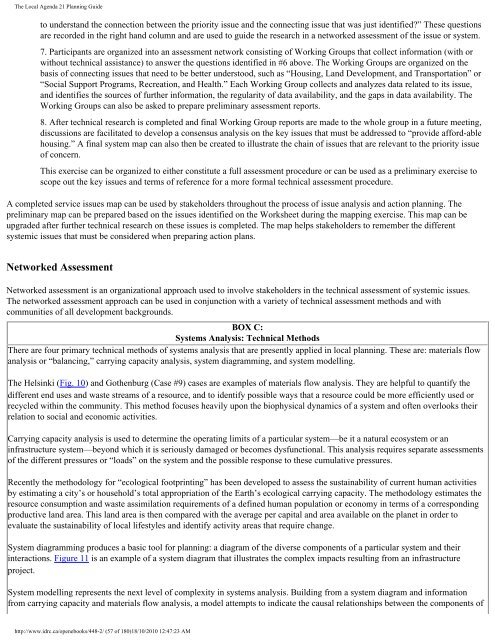The Local Agenda 21 Planning Guide - Democrats Against UN ...
The Local Agenda 21 Planning Guide - Democrats Against UN ...
The Local Agenda 21 Planning Guide - Democrats Against UN ...
You also want an ePaper? Increase the reach of your titles
YUMPU automatically turns print PDFs into web optimized ePapers that Google loves.
<strong>The</strong> <strong>Local</strong> <strong>Agenda</strong> <strong>21</strong> <strong>Planning</strong> <strong>Guide</strong><br />
to understand the connection between the priority issue and the connecting issue that was just identified?” <strong>The</strong>se questions<br />
are recorded in the right hand column and are used to guide the research in a networked assessment of the issue or system.<br />
7. Participants are organized into an assessment network consisting of Working Groups that collect information (with or<br />
without technical assistance) to answer the questions identified in #6 above. <strong>The</strong> Working Groups are organized on the<br />
basis of connecting issues that need to be better understood, such as “Housing, Land Development, and Transportation” or<br />
“Social Support Programs, Recreation, and Health.” Each Working Group collects and analyzes data related to its issue,<br />
and identifies the sources of further information, the regularity of data availability, and the gaps in data availability. <strong>The</strong><br />
Working Groups can also be asked to prepare preliminary assessment reports.<br />
8. After technical research is completed and final Working Group reports are made to the whole group in a future meeting,<br />
discussions are facilitated to develop a consensus analysis on the key issues that must be addressed to “provide afford-able<br />
housing.” A final system map can also then be created to illustrate the chain of issues that are relevant to the priority issue<br />
of concern.<br />
This exercise can be organized to either constitute a full assessment procedure or can be used as a preliminary exercise to<br />
scope out the key issues and terms of reference for a more formal technical assessment procedure.<br />
A completed service issues map can be used by stakeholders throughout the process of issue analysis and action planning. <strong>The</strong><br />
preliminary map can be prepared based on the issues identified on the Worksheet during the mapping exercise. This map can be<br />
upgraded after further technical research on these issues is completed. <strong>The</strong> map helps stakeholders to remember the different<br />
systemic issues that must be considered when preparing action plans.<br />
Networked Assessment<br />
Networked assessment is an organizational approach used to involve stakeholders in the technical assessment of systemic issues.<br />
<strong>The</strong> networked assessment approach can be used in conjunction with a variety of technical assessment methods and with<br />
communities of all development backgrounds.<br />
BOX C:<br />
Systems Analysis: Technical Methods<br />
<strong>The</strong>re are four primary technical methods of systems analysis that are presently applied in local planning. <strong>The</strong>se are: materials flow<br />
analysis or “balancing,” carrying capacity analysis, system diagramming, and system modelling.<br />
<strong>The</strong> Helsinki (Fig. 10) and Gothenburg (Case #9) cases are examples of materials flow analysis. <strong>The</strong>y are helpful to quantify the<br />
different end uses and waste streams of a resource, and to identify possible ways that a resource could be more efficiently used or<br />
recycled within the community. This method focuses heavily upon the biophysical dynamics of a system and often overlooks their<br />
relation to social and economic activities.<br />
Carrying capacity analysis is used to determine the operating limits of a particular system—be it a natural ecosystem or an<br />
infrastructure system—beyond which it is seriously damaged or becomes dysfunctional. This analysis requires separate assessments<br />
of the different pressures or “loads” on the system and the possible response to these cumulative pressures.<br />
Recently the methodology for “ecological footprinting” has been developed to assess the sustainability of current human activities<br />
by estimating a city’s or household’s total appropriation of the Earth’s ecological carrying capacity. <strong>The</strong> methodology estimates the<br />
resource consumption and waste assimilation requirements of a defined human population or economy in terms of a corresponding<br />
productive land area. This land area is then compared with the average per capital and area available on the planet in order to<br />
evaluate the sustainability of local lifestyles and identify activity areas that require change.<br />
System diagramming produces a basic tool for planning: a diagram of the diverse components of a particular system and their<br />
interactions. Figure 11 is an example of a system diagram that illustrates the complex impacts resulting from an infrastructure<br />
project.<br />
System modelling represents the next level of complexity in systems analysis. Building from a system diagram and information<br />
from carrying capacity and materials flow analysis, a model attempts to indicate the causal relationships between the components of<br />
http://www.idrc.ca/openebooks/448-2/ (57 of 180)18/10/2010 12:47:23 AM










